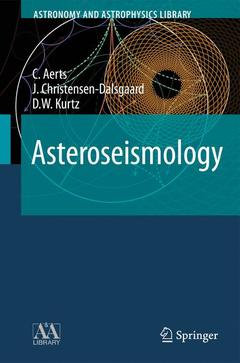Asteroseismology, 2010 Astronomy and Astrophysics Library Series
Auteurs : Aerts C., Christensen-Dalsgaard J., Kurtz D. W.

Conny Aerts is full professor at the University of Leuven, Belgium, as well as professor by special appointment on the Chair Asteroseismology, University of Nijmegen, The Netherlands. Jørgen Christensen-Dalsgaard is full professor of helio- and asteroseismology at Aarhus University, Denmark. Don Kurtz is full professor at the University of Central Lancashire, UK.
Their collective expertise encompasses all aspects of asteroseismology. All three authors are experienced lecturers and participate in numerous scientific committees. Their research teams enjoy international recognition and are heavily involved in various ground-based and satellite projects on asteroseismology.
First general introduction monograph available that deals with Asteroseismology
Covers all aspects from observations, methodology for data analysis, up to seismic interpretations of stars
Practical guide for graduate students or scientists working in the growing field of stellar astrophysics
Date de parution : 08-2016
Ouvrage de 866 p.
15.5x23.5 cm
Date de parution : 01-2010
Ouvrage de 866 p.
15.5x23.5 cm
Disponible chez l'éditeur (délai d'approvisionnement : 15 jours).
Prix indicatif 242,64 €
Ajouter au panier


